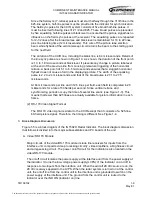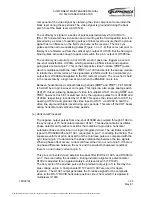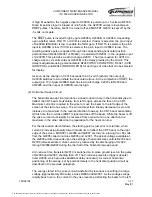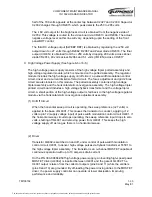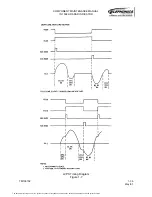
COMPONENT MAINTENANCE MANUAL
IN 1502H RADAR INDICATOR
TM109102
1-22
May/01
brightness circuit is the brightness (BRT) control mounted on the front panel of the
indicator. The brightness circuit operates from -160 volts developed at the sweep
module. An additional input (EN) is provided from the composite video enable circuit
to turn brightness control over to the composite video circuits when enabled.
This circuit provides a bias between -65 and -140 volts, depending upon the setting of
the BRT control, to grid 1 of the CRT. The -160 volts from the sweep module is applied
across C1082. The output voltage to grid 1 depends upon the voltage drop across
R1163. This voltage drop is proportional to the amount of current flow through R1161.
Transistor Q1013 is needed primarily to shift the output of U1017C below ground.
The output voltage (G1) is set by the current through R1161, which depends upon the
settings of the BRT control, maximum brightness potentiometer R1083 and minimum
brightness potentiometer R1086.
At the maximum brightness setting, the BRT control on the front panel presents a
ground at pin 1 of J1005. Therefore, all current through R1161 is supplied through
R1154 and R1155 and the negative bias at grid 1is minimum. Maximum brightness
potentiometer R1083 is set to provide a bias (-65 volts) that results in a display just
below blooming. At the minimum brightness setting, the BRT control presents about
+3 volts at pin 1 of J1005, through the voltage divider made up of the 1k-ohm BRT
potentiometer and the 2k-ohm resistor, R1151, on the video/RS170 module. The
minimum brightness adjust potentiometer, R1086, is set to provide a bias (-140 volts)
that results in a display that is just barely visible.
When composite video is enabled, the EN input to this circuit is set to logic-low level
by the composite video enable circuitry. This switches analog switch U1012D on,
applying ground to the non-inverting input of U1017D. This results in minimum
negative bias on G1, or the same condition that occurs with the BRT control fully
clockwise. CRT brightness is now controlled by the composite video circuitry in
conjunction with the setting of the BRT control. The BRT control setting is now sensed
by U1017B in the composite video circuitry and has no effect on the G1 bias to the
CRT.
(7) Composite Video Circuits
The composite video circuitry separates the line sync and field sync pulses from the
composite video input signal, amplifies the video to the level required to drive the
green gun of the CRT and generates the X-retrace and Y-retrace outputs,
synchronized to the line and field sync inputs. These circuits are described in detail in
the following paragraphs.
(a) Composite Video Input Circuit
The composite video input signal is approximately 1 volt peak-to-peak. It enters
the video/RS-170 module at P1001, pin 8 and is applied to U1001, which is a
high-speed, high-gain operational amplifier.
The output signal at pin 6 of U1001 is applied to multiplier U1011 and also
coupled through C1091 to sync separator U1005. Automatic gain control (AGC) is
provided by FET Q1004 and associated components.
The document reference is online, please check the correspondence between the online documentation and the printed version.


